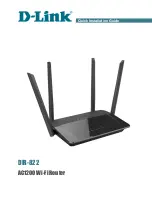
46
Configuring Interfaces
Monitoring and Maintaining the Interfaces
Using FEFI to Maintain the Fiber FE Interfaces
A far end fault is an error in the link that one station detects but the other does not, such as a disconnected Tx wire. In
this example, the sending station still receives valid data and detects that the link is good through the link integrity
monitor. The sending station does not detect that its own transmission is not being received by the other station. A
100BASE-FX station that detects a remote fault like this modifies its transmitted IDLE stream to send a special bit pattern
(FEFI IDLE pattern) to inform the neighbor of the remote fault. The FEFI-IDLE pattern then triggers a shutdown of the
remote port (notconnect).
Fiber FastEthernet hardware uses far end fault indication (FEFI) to bring the link down on both sides of the link in these
situations. A similar function is provided by link negotiation for Gigabit Ethernet. FEFI is not supported on copper ports,
which do not usually have issues in which one station can detect while the other cannot. Copper ports use Ethernet link
pulses to monitor the link.
With FEFI, no forwarding loop occurs because there is no connectivity between the ports. If the link is up on one side
and down on the other, however, blackholing of traffic might occur. Use Unidirectional Link Detection (UDLD) to prevent
traffic blackholing.
Default FEFI Configuration
FEFI is enabled globally and not configurable on the switch, however it applies only to the fiber Fast Ethernet SFP
interfaces on the switch.
show interfaces
[
interface-id]
transceiver
[
detail
|
dom-supported-list | module
number
| properties
| threshold-table
]
Display these physical and operational status about an SFP module:
interface-id–
(Optional) Display configuration and status for a
specified physical interface.
detail–
(Optional) Display calibration properties, including high and
low numbers and any alarm information for any Digital Optical
Monitoring (DoM)-capable transceiver if one is installed in the
switch.
dom-supported-list–
(Optional) List all supported DoM
transceivers.
module
number
–
(Optional) Limit display to interfaces on module
on the switch. The range is 1 to 9. This option is not available if
you entered a specific interface ID.
properties–
(Optional) Display speed, duplex, and inline power
settings on an interface
threshold-table–
(Optional) Display alarm and warning threshold
table
show interfaces
[
interface-id
] [{
transceiver
properties
|
detail
}]
module number
]
Display physical and operational status about an SFP module.
show port-type
[
eni
|
nni
|
uni
]
Display interface type information for the Cisco ME switch.
show running-config interface
[
interface-id
]
Display the running configuration in RAM for the interface.
show version
Display the hardware configuration, software version, the names and
sources of configuration files, and the boot images.
show controllers ethernet-controller
interface-id
phy
Display the operational state of the auto-MDIX feature on the
interface.
Table 8
Show Commands for Interfaces (continued)
Command
Purpose
Содержание IE 4000
Страница 12: ...8 Configuration Overview Default Settings After Initial Switch Configuration ...
Страница 52: ...48 Configuring Interfaces Monitoring and Maintaining the Interfaces ...
Страница 108: ...104 Configuring Switch Clusters Additional References ...
Страница 128: ...124 Performing Switch Administration Additional References ...
Страница 130: ...126 Configuring PTP ...
Страница 140: ...136 Configuring CIP Additional References ...
Страница 146: ...142 Configuring SDM Templates Configuration Examples for Configuring SDM Templates ...
Страница 192: ...188 Configuring Switch Based Authentication Additional References ...
Страница 244: ...240 Configuring IEEE 802 1x Port Based Authentication Additional References ...
Страница 274: ...270 Configuring SGT Exchange Protocol over TCP SXP and Layer 3 Transport Configuring Cisco TrustSec Caching ...
Страница 298: ...294 Configuring VLANs Additional References ...
Страница 336: ...332 Configuring STP Additional References ...
Страница 408: ...404 Configuring DHCP Additional References ...
Страница 450: ...446 Configuring IGMP Snooping and MVR Additional References ...
Страница 490: ...486 Configuring SPAN and RSPAN Additional References ...
Страница 502: ...498 Configuring Layer 2 NAT ...
Страница 559: ...555 Configuring Network Security with ACLs How to Configure Network Security with ACLs Creating a Numbered Extended ACL ...
Страница 770: ...766 Configuring IPv6 MLD Snooping Related Documents ...
Страница 930: ...926 Configuring IP Unicast Routing Related Documents ...
Страница 956: ...952 Configuring IPv6 Unicast Routing Configuring IPv6 network 2010 AB8 2 48 network 2010 AB8 3 48 exit address family ...
Страница 976: ...972 Configuring Cisco IOS IP SLAs Operations Additional References ...
Страница 978: ...974 Dying Gasp ...
Страница 990: ...986 Configuring Enhanced Object Tracking Monitoring Enhanced Object Tracking ...
Страница 994: ...990 Configuring MODBUS TCP Displaying MODBUS TCP Information ...
Страница 996: ...992 Ethernet CFM ...
Страница 1030: ...1026 Working with the Cisco IOS File System Configuration Files and Software Images Working with Software Images ...
Страница 1066: ...1062 Using an SD Card SD Card Alarms ...
















































